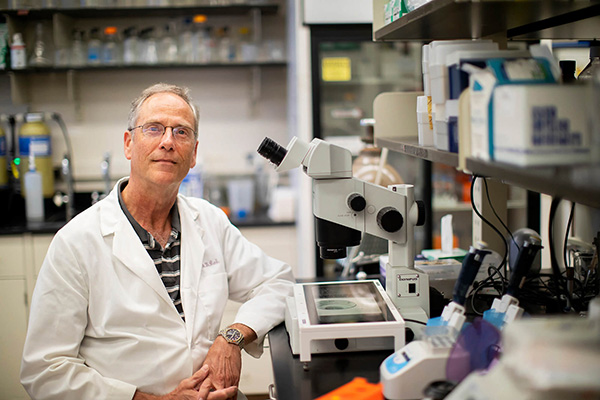Changing Landscape of Mosquito and Tick-Borne Diseases
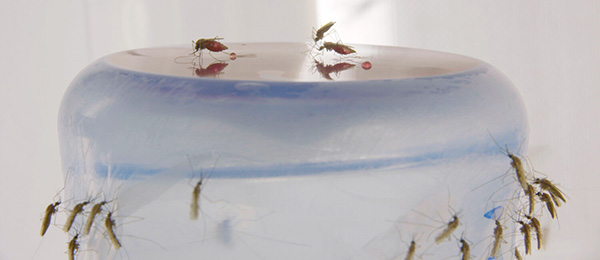
Mosquitoes take in a feeding in the insectary where the School of Veterinary Medicine’s Michael Povelones performs his research. Among the species he studies are Aedes mosquitoes, which can transmit diseases
including Zika, dengue, and heartworm.
Penn Vet by: Katherine Unger Baillie
Sara Cherry has a visceral memory of when Asian tiger mosquitoes, Aedes albopictus, first found their way into the Philadelphia region.
“I used to like to eat outside with my lab when I first started working here at Penn,” she says. “But then the tigers came and started terrorizing us and we had to eat inside. They are aggressive, and their bites cause welts.”
Vectors of viral diseases including yellow fever, Zika, dengue, and chikungunya, A. albopictus and its close relative Aedes aegpyti have undergone a dramatic global expansion in recent years, and now dwell contentedly in the yards and outdoor spaces frequented by hundreds of millions of Americans.
To Cherry, a professor in Penn’s Perelman School of Medicine who studies viruses transmitted by mosquitoes, the tiger mosquitoes are emblematic of the changes afoot when it comes to vector-borne disease, changes wrought in many cases by climate change and globalization.
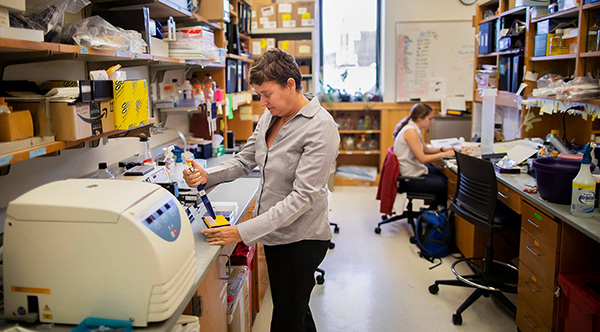
Sara Cherry, a professor of microbiology in the Perelman School of Medicine, studies viruses transmitted by mosquitoes.
According to the U.S. Centers for Disease Control and Prevention, diseases transmitted by mosquitoes and ticks represent a growing public health problem. From 2004 to 2016, the agency found that insect-borne diseases more than tripled, with nine new-to-the-U.S. diseases emerging in that period. Meanwhile, in the last several months, an introduced tick species has been reported in the eastern U.S., raising concerns about how this new player in the landscape could influence disease risks.
With potential dangers lurking within the bodies of tiny insects, the question may surface: Is it safe to venture outside anymore? Penn researchers, keeping tabs on the news and making headway in the lab, offer a clear-eyed—though not cut-and-dry—view of the state of vector-borne disease. The threats may be real, they note, but the precautions are generally straightforward.
Risks, old and new
James Lok of Penn’s School of Veterinary Medicine specializes in parasite biology, but also teaches students about the ins and outs of a wide variety of zoonotic diseases transmitted by insects. He sees a connection between global travel and global commerce and the new threats posed to the continental U.S. by exotic diseases once only associated with tropical areas, such as Zika and chikungunya virus.
“The global economy and globalization generally have been social trends that have fostered a lot of these diseases,” Lok says. “There are a lot of ways that a tick like the exotic one found in New Jersey can hitch a ride on livestock and get over here, then when they’re in, they’re in.”
The introduced tick, Haemaphysalis longicornis, with a common name of longhorned or bush tick, was found on a sheep last year and seems to have overwintered in New Jersey. This spring, reports cropped up in Virginia, West Virginia, and Arkansas as well.
“This tick is known to be an aggressive invader,” says Dustin Brisson, a biologist in the School of Arts and Sciences who studies the ecological and evolutionary trends of the bacteria that causes Lyme disease and of Ixodes scapularis, the black-legged tick that carries it. H. longicornis is already known to spread viral diseases in its native East Asia.
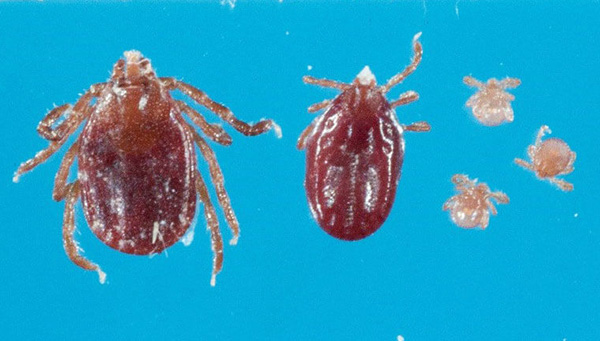
Last August, a sheep in New Jersey was found to be infected with hundreds of Haemaphysalis longicornis ticks, a species native to Asia. Researchers are now investigating the distribution of the exotic tick, and whether it poses a risk to human and animal health. James L. Occi/Rutgers University.
Last August, a sheep in New Jersey was found to be infected with hundreds of Haemaphysalis longicornis ticks, a species native to Asia. Researchers are now investigating the distribution of the exotic tick, and whether it poses a risk to human and animal health. James L. Occi/Rutgers University.
Brisson says that with a new vector like this, researchers generally have two sets of questions. “The more immediate ones relate to its vector competence,” he says. “Can it transmit diseases that we already have here in North America? Where are the risks?”
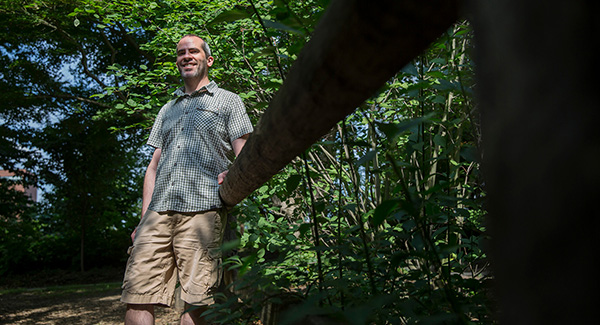
Dustin Brisson, a biologist in the School of Arts and Sciences, studies the ecological and evolutionary trends of the bacteria that causes Lyme disease and of Ixodes scapularis, the black-legged tick that carries it. Photo by Denise Henhoeffer.
Equally important but less urgent, he says, are a second set of questions relating to the tick’s ecology. “Does it displace other organisms, like Ixodes scapularis? What effect does it have on animal communities? What kind of densities does it live at? These are questions that can play back into public health,” Brisson says.
Meanwhile, our native black-legged ticks have been busy, transmitting Lyme disease in ever-increasing numbers, accounting for more than 80 percent of tick-borne diseases. Other, more dangerous infections, such as Powassan virus and anaplasmosis, are also transmitted by these ticks. Brisson’s research has examined what types of landscapes are most likely to harbor ticks, and the role of certain host species in the transmission of different strains of the Lyme bacteria. Pulling together this information into large-scale models of the environmental features that influence disease risk in humans could inform long-term disease management strategies, he says.
‘
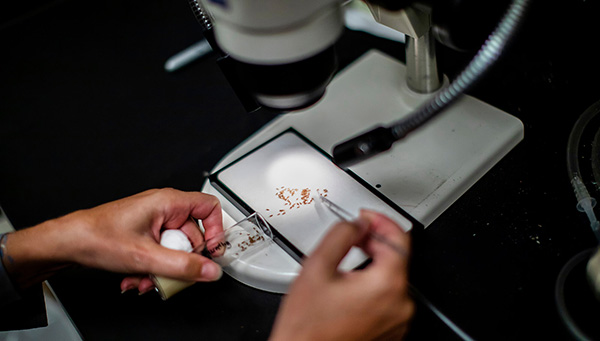
Members of Cherry’s lab use fruit flies as a model for studying a variety of disease-causing viruses that are transmitted by mosquitoes, for example West Nile and chikungunya viruses.
Emerging’ disease
Scientists lump together a host of pathogens into the category known as “emerging infectious diseases.” Oftentimes, however, these infections aren’t brand new, they’re just new to the developed world, says Cherry.
“It may be an unpopular view, but we have very little understanding of these diseases because historically they’ve mainly affected developing nations,” she says.
Yet that geographic disparity is breaking down of late. One need look no further than the outbreak of Zika in 2015 to 2017 to see how a virus once primarily confined to Brazil impacted the continental U.S. And while that outbreak is past, other infections, such as dengue and chikungunya, circulate in the Caribbean and are believed to pose a threat to the U.S., especially now that their vectors, certain Aedes mosquitoes, have become well-established here.
Members of Cherry’s lab use fruit flies as a model for studying a variety of disease-causing viruses that are transmitted by mosquitoes, for example West Nile and chikungunya viruses.
Cherry’s lab studies these viruses and many others, seeking commonalities in how these pathogens infect both mosquitoes and humans. The goal is to find potential drug targets to shut down viral spread—ideally targets that could work to treat more than one disease.
Despite her focus on viruses, Cherry believes that, currently, the best strategy for combatting these types of diseases is targeting the vectors, not the pathogens.
“When there was an outbreak of yellow fever in the 1700s in Philadelphia, what did we do? We killed the mosquitoes,” she says. “What is the best tool we have against malaria in Africa? Bed nets. When you step back, we don’t know a lot about how to deal with these diseases, but we do know how to kill and manage insects.”
Michael Povelones is one researcher investigating ever-more sophisticated ways of manipulating mosquitoes to benefit human health. In a high-tech insectary in the School of Veterinary Medicine, Povelones’s lab rears and infects mosquitoes with a variety of pathogens, then studies how the insects’ own immune systems do battle with the invaders. The insects’ ability to either vanquish or succumb to infection with, for example, malaria, has implications for whether they’ll be able to pass the parasite onto humans.
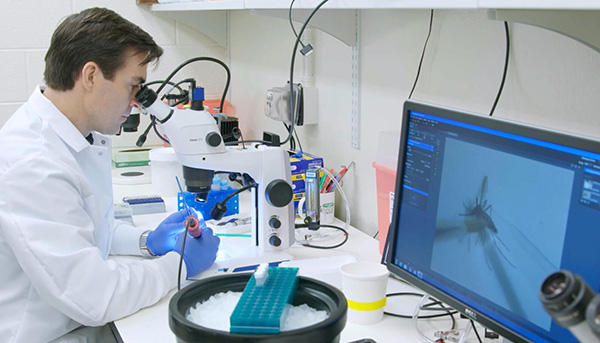
Michael Povelones, an assistant professor of pathobiology at the School of Veterinary Medicine, is investigating ever-more sophisticated ways of manipulating mosquitoes to benefit human health.
A long-term possibility stemming from Povelones’s work would be to manipulate the mosquito immune system in such a way so the insect would no longer be able to transmit disease. While we may be far off from the widespread release of genetically modified mosquitoes, California has already seen the release of millions of mosquitoes infected with Wolbachia, a genus of bacteria that renders mosquitoes sterile, orchestrated by Google’s sister company, Verily. Kaycie Hopkins, a Penn grad who completed her Ph.D. working in Cherry’s lab, is one of the biologists collaborating with software engineers and automation experts on these projects at Verily.
“I’m heartened by the fact that there are companies and organizations working on these large-scale efforts,” Povelones says.
Mosquito-transmitted diseases are not only a problem for humans; they infect wild and domestic animals as well. In a project taken up over the last couple of years, Povelones and members of his lab have been investigating what makes certain mosquito species resistant to heartworm, and others susceptible. While medications already on the market effectively keep pets free of heartworm, Povelones says isolated reports of drug-resistant heartworm give reason to look for other strategies to go after the parasite, in addition to the swells of infections that arise among feral and shelter animal populations, especially during hurricane season in the South.
Brass tacks
While the news about scary-sounding diseases like chikungunya or anaplasmosis can feel overwhelming, the researchers underscore that simple precautions can make a big dent in the risk of acquiring a vector-borne infection:
- High potency DEET insect repellants remain the gold-standard for avoiding both tick and mosquito bites. Other repellants, such as permethrin, are effective at keeping away ticks when applied to clothing.
- When venturing into tick habitat—think of landscapes where forests meet shorter vegetation, like wooded paths lined by taller grasses—wear long pants and long sleeves as well as insect repellant. Then do a thorough body check for ticks upon returning home. “An entomologist I spoke with said that taking these kinds of tick precautions should be as engrained a behavior as fastening your seat belt in the car,” says Lok.
- Eliminate standing water that can provide mosquito breeding habitats near home environments. A. aegypti and A. albopictus larvae can thrive in an upturned bottle cap. “There’s no point in hiring a firm to spread insecticide over your property if you’re not going to dump out the water collecting in your planters, or if you’re leaving your dog’s water dish out for days at a time,” says Cherry.
- Keep pets up-to-date on vaccinations and use FDA-approved medications or collars to prevent diseases such as heartworm and deter fleas, ticks, and mosquitoes.
- Consult a physician about any needed vaccinations or preventive therapies when traveling abroad to countries where vector-borne diseases may be prevalent.
In other words, continue to enjoy outdoor activities, keeping in mind that there is reason to be cautious.
“I don’t think people should panic,” says Cherry, “but I do think they should learn the world is getting small. You can’t just put your head down and think that only people in other countries get these diseases; we’re all the same place now—it’s one place now.”
Dustin Brisson is an associate professor of biology in the School of Arts and Sciences.
Sara Cherry is a professor of microbiology in the Perelman School of Medicine.
James Lok is a professor of parasitology in the School of Veterinary Medicine.
Michael Povelones is an assistant professor of pathobiology in the School of Veterinary Medicine.
About Penn Vet
Ranked among the top ten veterinary schools worldwide, the University of Pennsylvania School of Veterinary Medicine (Penn Vet) is a global leader in veterinary education, research, and clinical care. Founded in 1884, Penn Vet is the first veterinary school developed in association with a medical school. The school is a proud member of the One Health initiative, linking human, animal, and environmental health.
Penn Vet serves a diverse population of animals at its two campuses, which include extensive diagnostic and research laboratories. Ryan Hospital in Philadelphia provides care for dogs, cats, and other domestic/companion animals, handling nearly 35,000 patient visits a year. New Bolton Center, Penn Vet’s large-animal hospital on nearly 700 acres in rural Kennett Square, PA, cares for horses and livestock/farm animals. The hospital handles nearly 4,900 patient visits a year, while the Field Service treats more than 38,000 patients at local farms. In addition, New Bolton Center’s campus includes a swine center, working dairy, and poultry unit that provide valuable research for the agriculture industry.










